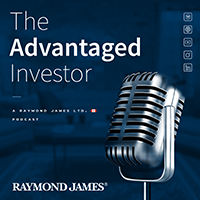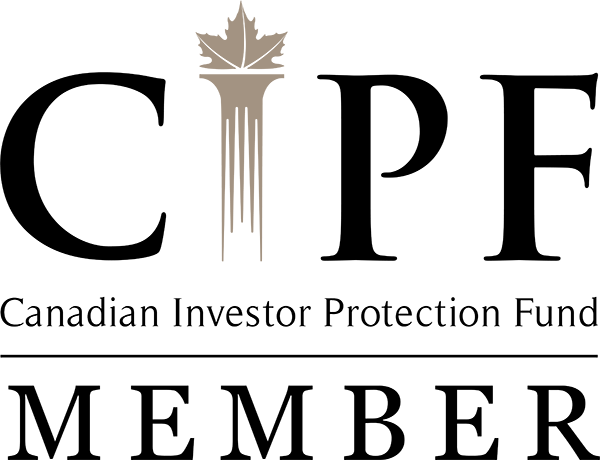Fixed Income Options for Portfolios (Ep 99)

Charlotte Jakubowicz, VP Fixed Income and Currencies joins host Chris Cooksey to discuss the options available in the fixed income market from the traditional bonds and GICs to newer alternative options, including:
- What are the options available?
- Approaches to fixed income investing
- Bank of Canada rate cuts and the effect on the fixed income market
Follow the podcast on LinkedIn: The Advantaged Investor
Please subscribe, rate and review. Reach out at advantagedinvestorpod@raymondjames.ca
Transcript
Chris Cooksey: Hello and welcome to the Advantaged Investor, a Raymond James Limited podcast that provides perspective for Canadian investors who want to remain knowledgeable, informed, and focused on long term success. We are recording this on July 9, 2024. I'm Chris Cooksey from the Raymond James Corporate Communication and Marketing Department and today, Charlotte Jakubowicz, I came close there, Charlotte, VP Fixed Income and Currencies joins us to discuss the options available within the fixed income market. Welcome to the Advantaged Investor, Charlotte. I really appreciate you taking your time today.
Charlotte Jakubowicz: Thank you so much, Chris. Happy to be here.
Chris Cooksey: Great to hear. Now I reached out to you because I came across an article on the advisor.ca website entitled, Fixed income investing, traditional or alternative options, and I thought to myself, who would be interesting to talk to about this article or the article’s premise anyway. So here we are. You were the lucky one. And obviously for those who can't see, I'm doing air quotes on that. The article basically covers a few options on how to set up a fixed income portfolio or the fixed income sleeve of your portfolio in a general manner. And I think a lot of people think that bonds and GICs are fixed income, but you and I both know that the fixed income market is large, and if I'm not mistaken, quite a bit larger than the equity markets. So, I thought we could talk about that today. Does that make sense to you?
Charlotte Jakubowicz: That sounds great.
Chris Cooksey: Awesome. So basically, in this article, there were four options that the author wrote about. The first one is “stay traditional”. So that's more your bonds, GICs, I guess with that. Of course, may include some of the provincial or Canadian savings bonds, which aren't, I guess, really bonds in the grand scheme of things. But maybe we just talk about the traditional side of things and what that means for investors.
Charlotte Jakubowicz: Yeah, so a lot of individuals when they're looking to invest, they do think of those more traditional options. Like you mentioned, corporate bonds, government bonds are really the first that come to mind, along with the GICs, which are guaranteed investment certificates, and, often, this is what populates a lot of the portfolios in Canada. So definitely a good approach to utilize.
Chris Cooksey: Right. And obviously bonds would include both governments, corporates, there's lots of options within there. As you said, these are the ones that probably drive most portfolios.
Charlotte Jakubowicz: Exactly, exactly.
Chris Cooksey: All right, now the second one, we start moving into alternatives and as we saw over COVID, I know we saw a lot of ETF fixed income options come out, so maybe we can just start hitting some of these alternative options that are out there.
Charlotte Jakubowicz: Yeah, for this individual who contributed to this approach really looked at more of a holistic way, and a lot of different sleeves within fixed income. Similar to equity, the overall umbrella where you have just stocks, but then when you delve down into where those stocks are located, the different sector breakdown, technology for example, versus consumer discretionary. The same thing happens on the fixed income side, but those buckets are really populated by different names. So in this case, he looked at mortgage funds as an opportunity for investment, private debt, infrastructure funds. So a lot of different things that are not really the first items to think about, but definitely part of the overall fixed income umbrella, for sure.
Chris Cooksey: All right, so that makes sense. And then we start getting into the more complicated things, I would say. You know, covered calls and convertible bonds and all those fun things. So maybe a quick overview on those.
Charlotte Jakubowicz: So convertible bonds, you know, traditionally are an exchange traded product. But one of the things I like about this covered call bond strategy that he mentioned is that it's an ETF, which means that it's not an individual investor who's making these decisions and trying to complete the strategy themselves. Of course, there are a lot of individual portfolio managers or financial advisors who could complete that, but you're really relying to an expert or deferring to an expert to complete these strategies for you. So I think it's a better approach when you're talking about things that are a little bit more complicated, more moving parts really, in these types of strategies.
Chris Cooksey: Yeah, that makes sense to like for most individuals they're not going to know all the options and I know like our advisors have the screens that that your team helps develop for their use and that sort of thing. I remember years ago I bought a bond. I'd never even heard of the company. I was just chasing yield, which is not a good strategy, by the way, or at least I've personally found out not a good strategy. So would you agree with that part of it? It's more just the the giganticness of the market. It's impossible for, unless you're in this day to day, to know all the available options.
Charlotte Jakubowicz: Completely. I mean, I think, you know, there's a quick stat that the fixed income market overall, globally, is about three times the size of the equity market. That doesn't really highlight the, the day-to-day transactions that occur, right? So, of course, that varies. One good measure is new issues in a particular space or sector. For fixed income, in the first quarter alone, we had over $105 billion dollars, billion with a B, of new securities come online. Now, of course, a lot of that comes from government funding. So, whether it be federal or provincial, you are having a lot of money being raised in the fixed income market. So it's a lot of individuals who are purchasing those products. So definitely a vast depth in the fixed income markets for sure.
Chris Cooksey: And one thing I found interesting about fixed income is, whether it's in the U. S. with maple bonds or, you know, in Canada, the Government of Canada will issue bonds in foreign currency as well, should they see an opportunity there. Is that right?
Charlotte Jakubowicz: Yeah, I don't know if the Government of Canada has issued recently, but definitely provinces you see issue in U.S. dollars. If there's particular need in that currency, it just allows you to perhaps match an investor. So if investors in some cases need particular funds, or if you have a need for that capital, it might make sense to invest where those funds are going to be used at the end of the day.
Chris Cooksey: Right. Now, the fourth approach they talk about is a blended approach, which I'm going to guess is what one we would highly recommend. To me, that's about portfolios. I could be a bit wrong, but maybe just talk about how these portfolios can work together, I guess.
Charlotte Jakubowicz: There are a lot of ways of creating a portfolio that works for you. And of course, we're always driven by the client situation. But for me myself, if I look at my own fixed income sleeve of my portfolio I tend to invest in individual securities. It gives me a little bit more control in terms of matching a particular maturity, for example, a credit quality a lot of these factors that when you buy other types of products, unitized products, it might be harder to identify. Now with every benefit, there's always a negative perhaps, and in that case, it's really being able to complete diversification. So when you're buying individual securities, it's harder to reach that amount, you'll have to invest a little bit more capital to reach that point, whereas when you're buying unitized products and ETF or a mutual fund, you can get to that point a lot quicker because that portfolio manager is able to have that element of scale and create that diversification a lot faster.
Chris Cooksey: Now just in a shout out to our friend and colleague Harvey Libby, every time Harvey's on here, we're talking about the actual markets, what's going on, what he sees in there, one of the things he always highlights is laddering those bonds. So I guess that's what you're talking about in terms of maturity, staggering things, so you can take advantage of what's going on.
Charlotte Jakubowicz: Definitely. It's a conservative approach that we often recommend. It allows you to create you know, to use the metaphor of a ladder, just different rungs at different periods of time. It allows you to stay invested in the markets as rungs mature, roll off, you can put it back to the top of the ladder, reinvest that capital, and just know that you're always going to be invested whether markets move up or move down, you're not really tied to a particular interest rate environment. You're just kind of rolling with the punches, so to speak and smoothing out those different bumps in the road.
Chris Cooksey: Right, and now we'll just finish off with a little Bank of Canada talk here. Everyone likes to predict where interest rates are going. Everyone always, well, it's hard to get that exactly right anyway. We started to see them go down a bit in Canada. Talk about it in the U. S. as well. What does that mean for fixed income? There’s talk out there and the actual real change from, you know, for a long time we didn't have a very high interest rate and then we went way up. So, what does that mean for fixed income?
Charlotte Jakubowicz: Yeah, go back to when we did have that, I believe, it was a quarter point at the lows and then you know, as far as I understand it, the fastest move in interest rates that we've ever seen in Canada, up to the high of 5%. And it took a very short amount of time to get to that five percent. And Chris, to your point about it being hard to predict, it really is a challenge to get it right bang on, but we can always talk about the broad strokes, right? So when you look at the longer trend of fixed income today we definitely agree and anticipate that the trend is downwards, that we'll see the Bank of Canada continue to cut rates. Different individuals have a different belief of how fast or how quickly we'll get the next rate cut, for example, but that first rate came in early June, I believe June 5, and some individuals felt that it took too long. Others felt that we should have waited longer. The Bank of Canada, after they complete these rate cut announcements, they do publish a communication about their deliberation processes and this is called the Summary of Deliberations. And within that, we saw that the Governing Council of the Bank of Canada was undecided, not undecided, excuse me, had different opinions about whether or not to move in June or to wait until July. Now, of course, there's a ton of information to consider, whether it be CPI, housing data, job numbers, there's a lot of information out there, just to name a few of the key drivers in terms of economic indicators that the BoC would be looking at but they did decide to move ahead with the quarter point. We're looking at a rate cut in June, but we're looking out further now into when we'll get the next one. Right now, for for the end of July, predictions are about two thirds believe we'll get another rate cut. A third of course, think we're going to delay, but looking out into September, which is the next rate cut, excuse me, the next rate decision meeting, by then almost everyone agrees that we'll get another rate cut. That one is coming on the horizon. Just a matter of when now with fixed income. One of the key factors is that price and yield are inversely related. So as one goes up, the other falls. If you're holding fixed income today and you have a particular yield and that yield is reduced, a lot of it coming from a cut to the Bank of Canada, the price actually increases. So for current holders of fixed income, you'll see those particular lines increase in value. That's why we're really encouraging investors to look at fixed income, to purchase new positions in today's environment, lock in a particular yield, and actually have a potential of see those securities increase in value over the next couple periods of time.
Chris Cooksey: Also, I think when rates went up and then they paused at the beginning of the rate cycle, everyone still felt good, but then eventually, it takes a while for these interest rates to start getting into the economy as Harvey has explained to that to us a few times on here. I imagine it's the same on the way back down to, it takes a time for everyone to start feeling those effects if you're in a variable mortgage, you've gotten used to what it is, you've made adjustments probably to your lifestyle because of that, but you just automatically don't start spending the difference on that rate decrease. So how long does it normally take for these things to start biting in the economy?
Charlotte Jakubowicz: It really depends. It really depends what aspect of the economy you're looking at. I think a lot of people who are more blessed to have higher salaries, more capital to invest on a day to day basis, when those individuals are starting to feel the pressure of either a mortgage or different payments out there through the increase in inflation it becomes more apparent to the masses. No one really cares if one person is complaining about the price of lettuce, but when everyone's complaining about the price of lettuce, it's a louder cry for, for lack of a better term. You did mention the variable rate mortgages, but of course there are the fixed rate mortgages, which are often a very popular alternative to variable. A lot of those individuals, they're still up for renewal. So of course, we continue to see time move past us more and more of those individuals will be coming coming due and renewing. But there are a lot of individuals who still have mortgages at rates that were set out when we were closer to the lows and when they come due, we will continue to see the pressures on the economy from individuals just having to carry a larger mortgage balance. Or not balance, rather, but with the payments.
Chris Cooksey: Now, Charlotte, I just want to thank you for two things. Number one, I want to thank you for reading those Bank of Canada missives. I can only imagine the scintillating reading those are, so I'm glad we have people like yourself in charge of that and our advisors who work really hard to understand these things, so I don't have to. And number two, I just want to thank you for taking the time today to join us. I know you're really busy, and I hope you'll join us again.
Charlotte Jakubowicz: No, thank you so much. Chris. This was my first time on the podcast, it was a pleasure to be here and look forward to connecting with you soon.
Chris Cooksey: and your episode Wayne Gretzky 99 So you know, there we go.
Charlotte Jakubowicz: The great one. Thank you so much.
Chris Cooksey: There you go, I planned that, anyway, reach out to us at advantagedinvestorpod@raymondjames.ca. Subscribe through Apple, Spotify, or wherever you get your podcasts. Please contact your advisor with any questions you have. Thank you for taking the time to listen today. Until next time, stay well.
This podcast is for informational purposes, only statistics and factual data, and other information are from sources Raymond James limited believes to be reliable, but their accuracy cannot be guaranteed information is furnished on the basis and understanding that Raymond James limited. Is to be under no liability whatsoever in respect thereof. It is provided as a general source of information and should not be construed as an offer or solicitation for the sale or purchase of any product and should not be considered tax advice. Raymond James Advisors are not tax advisors and we recommend that clients seek independent advice from a professional advisor on tax related matters. Securities related products and services are offered through Raymond James Limited, member of the Canadian Investor Protection Fund. Insurance products and services are offered through Raymond James Financial Planning Limited, which is not a member of Canadian Investor Protection Fund.






